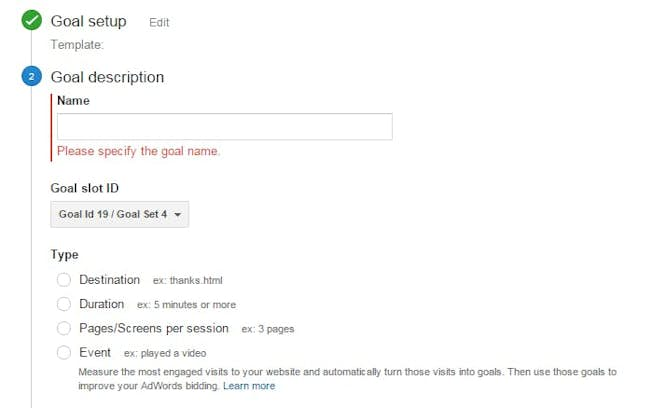What Data Is Google Analytics Goals Unable to Track: Vital Information
What Data Is Google Analytics Goals Unable to Track: Vital Information
Blog Article
Unveiling the Blind Destinations: Recognizing What Google Analytics Goals Can not Gauge
In the realm of digital analytics, Google Analytics stands as a powerful device for tracking and analyzing online individual communications. Amidst its robust capabilities, there exist blind spots that typically avert dimension. what data is google analytics goals unable to track. Comprehending what Google Analytics objectives can not determine is essential for getting a comprehensive view of user habits and interaction. As we look into the details of these dead spots, we reveal an intricate web of undiscovered areas that hold beneficial insights right into customer actions and inspirations, difficult standard wisdom and dropping light on the restrictions of our data-driven understanding.
User Habits on External Operatings Systems
Recognizing how users engage on exterior platforms is vital for optimizing online methods. Outside systems, such as social media networks, referral web sites, and on the internet forums, play a substantial role in driving website traffic to a business's site. By assessing user habits on these platforms, services can gain important insights into the performance of their marketing efforts and the preferences of their target market.
One key element of user habits on outside systems is the recommendation source. By tracking where the users are coming from, services can recognize which systems are driving the most traffic to their website. This information can assist firms assign their resources better, concentrating on the systems that yield the most effective outcomes.

Offline Interactions and conversions
Examining customer actions on exterior platforms supplies beneficial understandings into online strategies; nevertheless, taking into consideration offline conversions and interactions is just as critical for a comprehensive understanding of a business's general performance. While Google Analytics excels at tracking on-line interactions, it falls brief in catching the full client trip that commonly includes offline touchpoints. Offline conversions, such as in-store acquisitions or phone queries, play a substantial function in lots of organizations' success. Disregarding these interactions can lead to an altered view of the performance of advertising and marketing campaigns and general company efficiency.

Attribution Beyond Last Click
When diving right into the world of electronic advertising analytics, it comes to be vital to look beyond the single touchpoint of the last click for a much more detailed understanding of acknowledgment. While Google Analytics supplies useful insights right into user actions, relying entirely on last-click acknowledgment can be limiting - what data is google analytics goals unable to track. Attribution designs that surpass the last click provide a more nuanced sight of the consumer journey, thinking about all the touchpoints that bring about a conversion
Attribution beyond the last click allows marketing professionals to appoint credit to various interactions along the conversion path, offering a clearer picture of the efficiency other of various advertising and marketing networks. By discovering multi-touch acknowledgment models such as straight, time degeneration, or position-based attribution, businesses can better allocate their marketing spending plans and optimize their methods for optimal effect.
Recognizing the impact of each touchpoint in the conversion process is essential for making informed choices and optimizing ROI. By embracing attribution beyond the last click, companies can obtain much deeper understandings into client behavior and tailor their advertising initiatives better.
Cross-Device and Cross-Browser Monitoring

Likewise, cross-browser tracking complements cross-device monitoring by catching individual habits as they switch over in between different internet browsers. Comprehending how users connect with internet sites on numerous internet browsers can aid online marketers optimize their on the internet experiences to make certain consistency and capability throughout various systems.
Qualitative Information and Individual Intent
Comprehending customer intent with qualitative information analysis is critical for creating targeted digital advertising methods that reverberate with the demands and preferences of the target why not find out more audience. Qualitative information supplies understandings into the 'why' behind individual actions, dropping light on motivations, feelings, and preferences that quantitative data alone can not catch. By evaluating customer responses, comments, and interactions, online marketers can reveal beneficial info about individual intent, allowing them to customize their messaging, content, and offerings to much better align with what their audience is looking for.
Qualitative data likewise More about the author helps in understanding the context in which users engage with a web site or application. This contextual understanding makes it possible for marketing experts to develop even more relevant and personalized experiences, ultimately driving greater involvement and conversion rates. By diving into individual intent through qualitative information evaluation, services can get a deeper understanding of their target audience, resulting in much more reliable advertising strategies that fulfill customers' assumptions and demands.
Conclusion
Finally, Google Analytics objectives have restrictions in determining user habits on external systems, offline conversions, attribution past last click, cross-browser and cross-device monitoring, and qualitative information associated with customer intent. what data is google analytics goals unable to track. It is essential for organizations to be familiar with these dead spots in order to supplement their data analysis with other devices and methods to acquire a more extensive understanding of their target market and boost their overall digital marketing strategies
By evaluating customer behavior on these platforms, businesses can obtain beneficial understandings right into the efficiency of their advertising initiatives and the preferences of their target audience.
Examining user habits on outside platforms provides useful understandings right into online approaches; however, taking into consideration offline conversions and interactions is equally necessary for a comprehensive understanding of a firm's overall efficiency.In digital advertising analytics, relocating beyond last-click acknowledgment to discover cross-device and cross-browser monitoring is vital for acquiring an all natural understanding of user communications throughout numerous systems and devices. By examining user comments, comments, and communications, marketers can discover valuable information concerning individual intent, allowing them to tailor their messaging, content, and offerings to better line up with what their target market is looking for.
By diving right into customer intent through qualitative information analysis, businesses can gain a much deeper understanding of their target audience, leading to much more reliable marketing techniques that satisfy users' expectations and needs.
Report this page